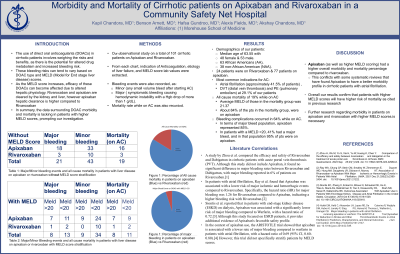Sunday Poster Session
Category: Liver
P1258 - Morbidity and Mortality of Cirrhotic Patients on Apixaban and Rivaroxaban in a Community Safety Net Hospital
Sunday, October 27, 2024
3:30 PM - 7:00 PM ET
Location: Exhibit Hall E

Has Audio

Benson Arnett, MD
Morehouse School of Medicine
Atlanta, GA
Presenting Author(s)
Kapil Chandora, MD, Benson Arnett, MD, Alexis Fields, MD, Akshay Chandora, MD, Hafsa Gundroo, MD
Morehouse School of Medicine, Atlanta, GA
Introduction: The use of direct oral anticoagulants (DOACs) in cirrhotic patients (pts) has always involved weighing the risks and benefits, as there is the potential for altered drug metabolism and increased bleeding risk. These bleeding risks can tend to vary based on DOAC type and MELD ( model for End stage liver disease) scores. For instance, Rivaroxaban and apixaban are both secreted by the kidney and liver, however apixaban hepatic clearance is higher compared to Rivaroxaban. As a pts MELD score increases, efficacy of these DOACs can become affected due to altered hepatic physiology. In summary, the data surrounding DOAC morbidity and mortality is lacking in pts with higher MELD scores, prompting our investigation.
Methods: In this observational study, a total of 101 cirrhotic pts on Apixaban and Rivaroxaban were included. From each chart, indication of Anticoagulation (AC), etiology of liver failure, and MELD score lab values were extracted. Bleeding events were also recorded, as minor (any small volume bleed after starting AC) or major ( symptomatic bleeding causing hemodynamic instability with a Hgb drop of more than 1 g/dL). Mortality rate while on AC was also recorded.
Results:
Our population had a median age 63.55 with 48 female & 53 male. Our racial demographics were 63 African Americans (AA), and 38 non-african american (NAA). We had 24 pts on Rivaroxaban and 77 on apixaban. In terms of indication for AC use, Afib was the highest at 41.5%, followed by DVT (distal vein thrombosis) and PE (pulmonary embolism) at 29.1%. Our study had a total 19% mortality rate, while on AC with 64% having some kind of bleeding complication while on AC. The average MELD of those in the mortality group was 21.37. About 84% of the pts in the mortality group, were on apixaban. In terms of major bleed population, apixaban represented 85%. In pts with a MELD >20, 41% had a major bleed, and in that population 95% of pts were on apixaban.
Discussion: In our study, apixaban (including MELD scoring) had a higher overall morbidity and mortality percentage compared to rivaroxaban. This result conflicts with some systematic reviews that have found Apixaban to have a better morbidity profile in cirrhotic patients with afib.
In total, pts with Higher MELD scores will have higher risk of mortality, as seen in our study, and this means careful monitoring is warranted in this population, however further research is necessary regarding morbidity in patients on apixaban and rivaroxaban with higher MELD scores.
Note: The table for this abstract can be viewed in the ePoster Gallery section of the ACG 2024 ePoster Site or in The American Journal of Gastroenterology's abstract supplement issue, both of which will be available starting October 27, 2024.
Disclosures:
Kapil Chandora, MD, Benson Arnett, MD, Alexis Fields, MD, Akshay Chandora, MD, Hafsa Gundroo, MD. P1258 - Morbidity and Mortality of Cirrhotic Patients on Apixaban and Rivaroxaban in a Community Safety Net Hospital, ACG 2024 Annual Scientific Meeting Abstracts. Philadelphia, PA: American College of Gastroenterology.
Morehouse School of Medicine, Atlanta, GA
Introduction: The use of direct oral anticoagulants (DOACs) in cirrhotic patients (pts) has always involved weighing the risks and benefits, as there is the potential for altered drug metabolism and increased bleeding risk. These bleeding risks can tend to vary based on DOAC type and MELD ( model for End stage liver disease) scores. For instance, Rivaroxaban and apixaban are both secreted by the kidney and liver, however apixaban hepatic clearance is higher compared to Rivaroxaban. As a pts MELD score increases, efficacy of these DOACs can become affected due to altered hepatic physiology. In summary, the data surrounding DOAC morbidity and mortality is lacking in pts with higher MELD scores, prompting our investigation.
Methods: In this observational study, a total of 101 cirrhotic pts on Apixaban and Rivaroxaban were included. From each chart, indication of Anticoagulation (AC), etiology of liver failure, and MELD score lab values were extracted. Bleeding events were also recorded, as minor (any small volume bleed after starting AC) or major ( symptomatic bleeding causing hemodynamic instability with a Hgb drop of more than 1 g/dL). Mortality rate while on AC was also recorded.
Results:
Our population had a median age 63.55 with 48 female & 53 male. Our racial demographics were 63 African Americans (AA), and 38 non-african american (NAA). We had 24 pts on Rivaroxaban and 77 on apixaban. In terms of indication for AC use, Afib was the highest at 41.5%, followed by DVT (distal vein thrombosis) and PE (pulmonary embolism) at 29.1%. Our study had a total 19% mortality rate, while on AC with 64% having some kind of bleeding complication while on AC. The average MELD of those in the mortality group was 21.37. About 84% of the pts in the mortality group, were on apixaban. In terms of major bleed population, apixaban represented 85%. In pts with a MELD >20, 41% had a major bleed, and in that population 95% of pts were on apixaban.
Discussion: In our study, apixaban (including MELD scoring) had a higher overall morbidity and mortality percentage compared to rivaroxaban. This result conflicts with some systematic reviews that have found Apixaban to have a better morbidity profile in cirrhotic patients with afib.
In total, pts with Higher MELD scores will have higher risk of mortality, as seen in our study, and this means careful monitoring is warranted in this population, however further research is necessary regarding morbidity in patients on apixaban and rivaroxaban with higher MELD scores.
Note: The table for this abstract can be viewed in the ePoster Gallery section of the ACG 2024 ePoster Site or in The American Journal of Gastroenterology's abstract supplement issue, both of which will be available starting October 27, 2024.
Disclosures:
Kapil Chandora indicated no relevant financial relationships.
Benson Arnett indicated no relevant financial relationships.
Alexis Fields indicated no relevant financial relationships.
Akshay Chandora indicated no relevant financial relationships.
Hafsa Gundroo indicated no relevant financial relationships.
Kapil Chandora, MD, Benson Arnett, MD, Alexis Fields, MD, Akshay Chandora, MD, Hafsa Gundroo, MD. P1258 - Morbidity and Mortality of Cirrhotic Patients on Apixaban and Rivaroxaban in a Community Safety Net Hospital, ACG 2024 Annual Scientific Meeting Abstracts. Philadelphia, PA: American College of Gastroenterology.
